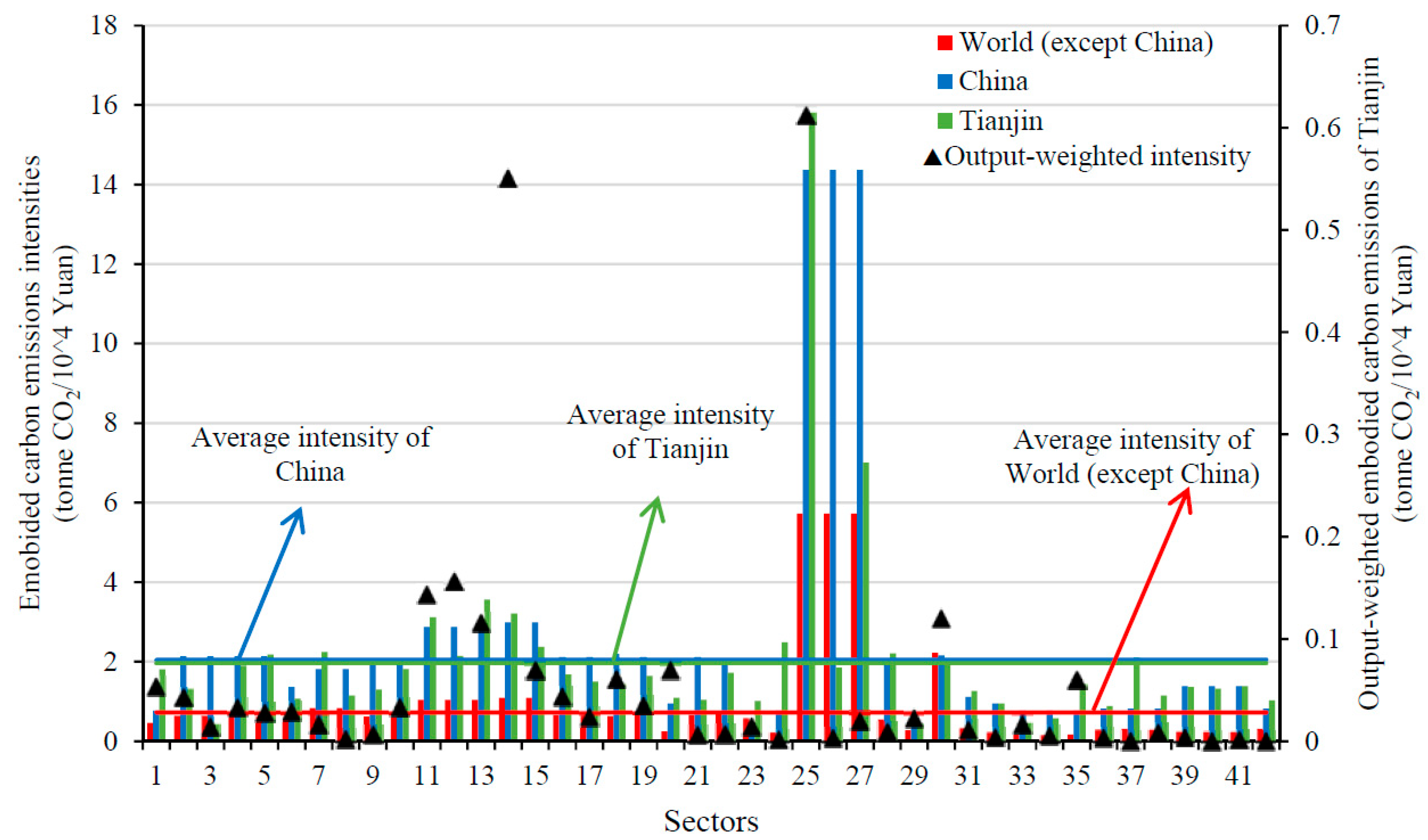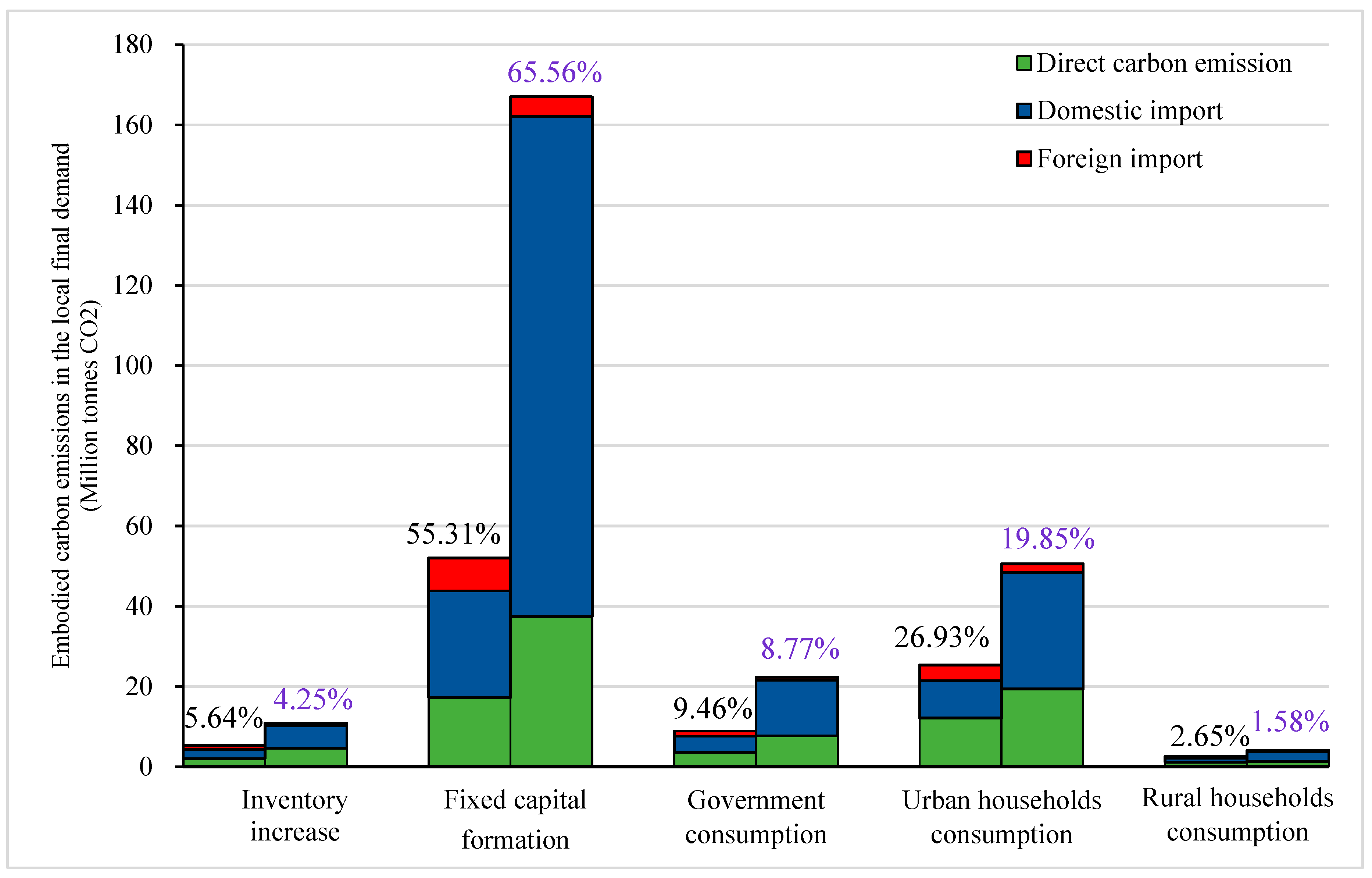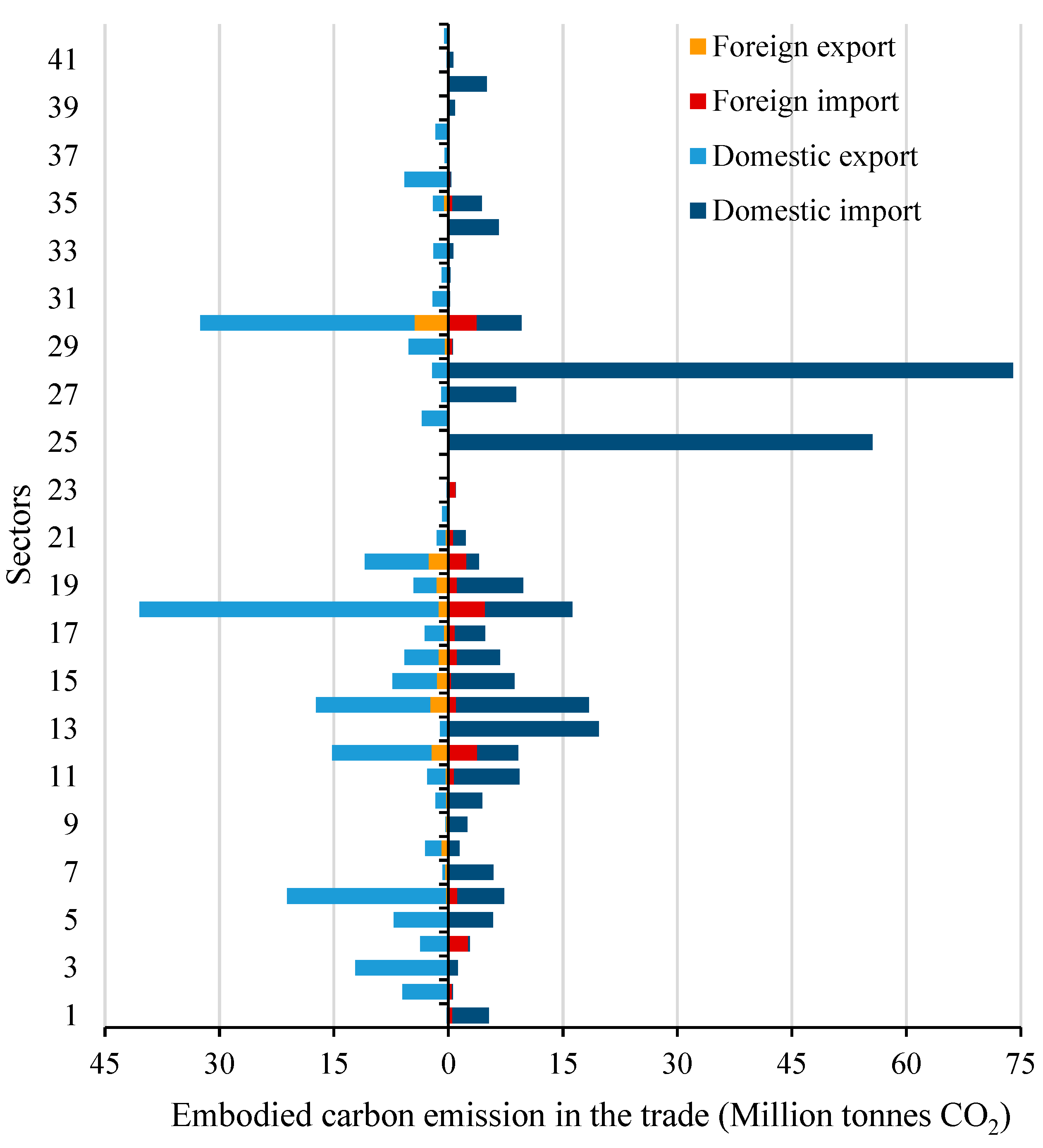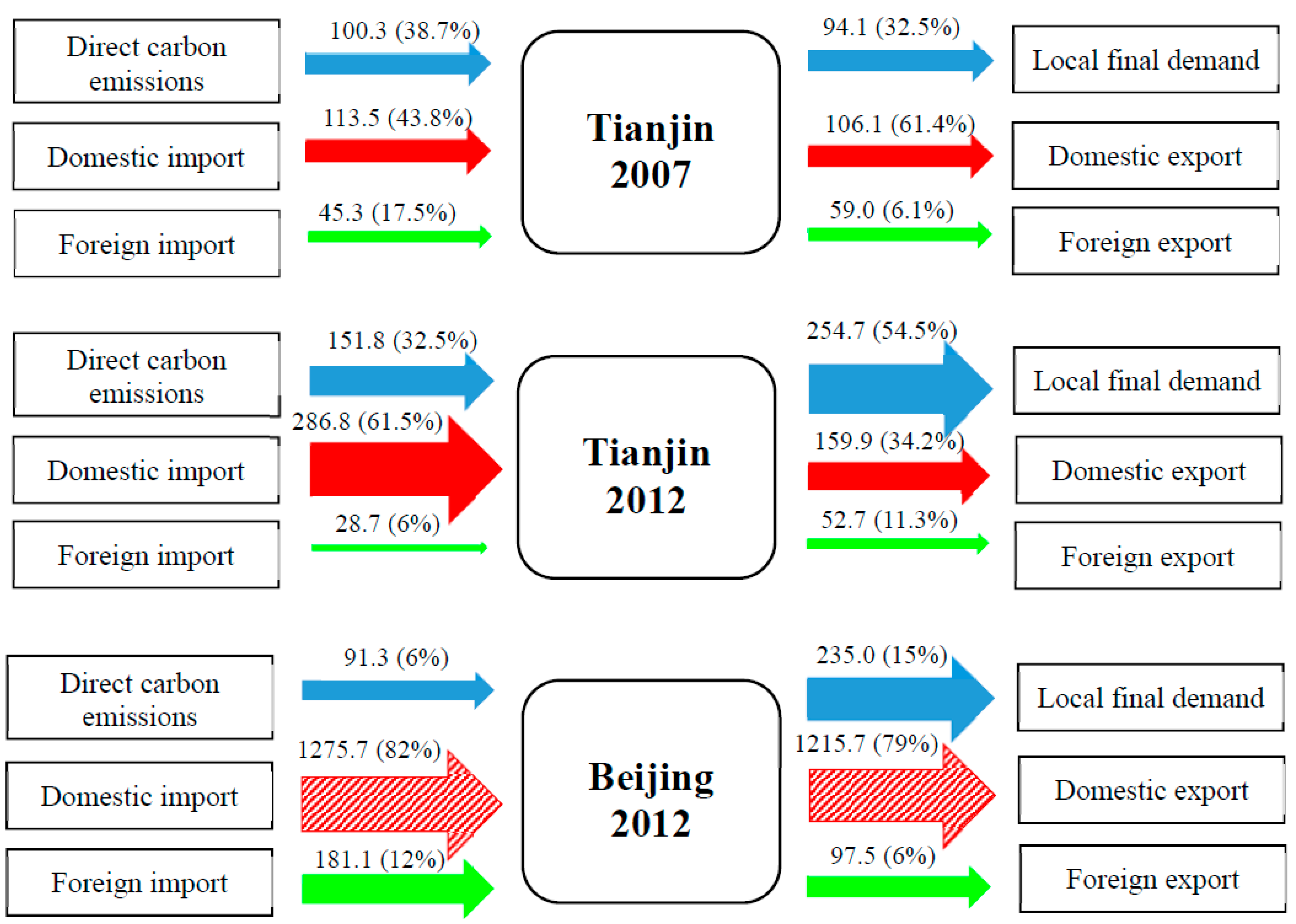Consumption-Based Carbon Emissions of Tianjin Based on Multi-Scale Input–Output Analysis
Abstract
1. Introduction
2. Methodology and Materials
2.1. Multi-Scale Input–Output (MSIO) Analysis
2.2. Data Sources
3. Results
3.1. Embodied Carbon Emissions Intensities of Tianjin in 2012
3.2. Carbon Emissions Embodied in the Local Final Demands of Tianjin in 2012
3.3. Carbon Emissions Embodied in Domestic and Foreign Trades of Tianjin in 2012
4. Discussions
4.1. Comparison of Embodied Carbon Emissions Flows of Tianjin in 2007 and 2012
4.2. Comparison of Embodied Carbon Emissions Flows of Beijing and Tianjin in 2012
5. Conclusions
Author Contributions
Funding
Conflicts of Interest
Appendix A
| No. | Sector | Corresponding Sector in Global (Excluding China) and Chinese Carbon Emission Intensity Database |
|---|---|---|
| 1 | Farming, Forestry, Animal Husbandry and Fishery | 1 (Agriculture) 2 (Fishing) |
| 2 | Mining and Washing of Coal | 3 (Mining and Quarrying) |
| 3 | Extraction of Petroleum and Natural Gas | 3 |
| 4 | Mining and Processing of Metal Ores | 3 |
| 5 | Mining and Processing of Nonmetal Ores and Other Ores | 3 |
| 6 | Manufacture of Foods and Tobacco | 4 (Food & Beverages) |
| 7 | Manufacture of Textile | 5 (Textiles and Wearing Apparel) |
| 8 | Manufacture of Textile Wearing Apparel, Footwear, Caps, Leather, Fur, Feather(Down) and Its products | 5 |
| 9 | Processing of Timbers and Manufacture of Furniture | 6 (Wood and Paper) |
| 10 | Papermaking, Printing and Manufacture of Articles for Culture, Education and Sports Activities | 6 |
| 11 | Processing of Petroleum, Coking, Processing of Nuclear Fuel | 7 (Petroleum, Chemical and Non-Metallic Mineral Products) |
| 12 | Chemical Industry | 7 |
| 13 | Manufacture of Nonmetallic Mineral Products | 7 |
| 14 | Smelting and Rolling of Metals | 8 (Metal Products) |
| 15 | Manufacture of Metal Products | 8 |
| 16 | Manufacture of General Purpose Machinery | 11 (Other Manufacturing) |
| 17 | Manufacture of Special Purpose Machinery | 11 |
| 18 | Manufacture of Transport Equipment | 10 (Transport Equipment) |
| 19 | Manufacture of Electrical Machinery and Equipment | 9 (Electrical and Machinery) |
| 20 | Manufacture of Communication Equipment, Computer and Other Electronic Equipment | 9 |
| 21 | Manufacture of measuring instrument and meter | 11 |
| 22 | Other manufacturing | 11 |
| 23 | Scrap and Waste | 12 (Recycling) |
| 24 | Repair of fabricated metal products, machinery and equipment | 15 (Maintenance and Repair) |
| 25 | Production and Supply of Electric Power and Heat Power | 13 (Electricity, Gas and Water) |
| 26 | Production and Distribution of Gas | 13 |
| 27 | Production and Distribution of Water | 13 |
| 28 | Construction | 14 (Construction) |
| 29 | Wholesale and Retail Trades | 16 (Wholesale Trade) 17 (Retail Trade) |
| 30 | Transportation, Storage, Posts and Telecommunications | 19 (Transport) |
| 31 | Hotels and Catering Services | 18 (Hotels and Restaurants) |
| 32 | Information transmission, software and information technology services | 20 (Post and Telecommunications) |
| 33 | Finance | 21 (Financial Intermediation and Business Activities) |
| 34 | Real Estate Trade | 21 |
| 35 | Tenancy and Commercial Services | 21 |
| 36 | Scientific research and development, technical services | 23 (Education, Health and Other Services) |
| 37 | Water, Environment and Municipal Engineering Conservancy | 23 |
| 38 | Resident services, repair and other services | 24 (Private Households) |
| 39 | Education | 23 |
| 40 | Health care and social works | 23 |
| 41 | Culture, Art, Sports and Recreation | 23 |
| 42 | Public administration, social security and social organizations | 22 (Public Administration) |
References
- National Bureau of Statistics China (NBSC). Available online: http://data.stats.gov.cn/easyquery.htm?cn=C01&zb=A0301&sj=2016 (accessed on 24 October 2019).
- Jiang, J. China’s urban residential carbon emission and energy efficiency policy. Energy 2016, 109, 866–875. [Google Scholar] [CrossRef]
- Department of Climate Change, National Development and Reform Commission, People’s Republic of China. Enhanced Actions on Climate Change: China’s Intended Nationally Determined Contributions; Department of Climate Change, National Development and Reform Commission, People’s Republic of China: Beijing, China, 2015. (In Chinese)
- Zhang, B.; Qiao, H.; Chen, B. Embodied energy uses by China’s four municipalities: A study based on multi-regional input–output model. Ecol. Model. 2015, 318, 138–149. [Google Scholar] [CrossRef]
- Shao, L.; Li, Y.; Feng, K.; Meng, J.; Shan, Y.; Guan, D. Carbon emission imbalances and the structural paths of Chinese regions. Appl. Energy 2018, 215, 396–404. [Google Scholar] [CrossRef]
- Mi, Z.; Zhang, Y.; Guan, D.; Shan, Y.; Liu, Z.; Cong, R.; Yuan, X.-C.; Wei, Y.-M. Consumption-based emission accounting for Chinese cities. Appl. Energy 2016, 184, 1073–1081. [Google Scholar] [CrossRef]
- Zhang, L.X.; Wang, C.B.; Yang, Z.F.; Chen, B. Carbon emissions from energy combustion in rural China. Procedia Environ. Sci. 2010, 2, 980–989. [Google Scholar] [CrossRef]
- Shao, L.; Chen, B.; Gan, L. Production-based and Consumption-based Carbon Emissions of Beijing: Trend and Features. Energy Procedia 2016, 104, 171–176. [Google Scholar] [CrossRef]
- Guo, C.X.; Shao, C.F.; Ju, M.T. Carbon emission accounting and decomposition analysis of energy consumption in the industrial sub-sectors of Tianjin City. Res. Environ. Sci. 2012, 25, 232–239. (In Chinese) [Google Scholar]
- Feng, K.; Hubacek, K.; Sun, L.; Liu, Z. Consumption-based CO2 accounting of China’s megacities: The case of Beijing, Tianjin, Shanghai and Chongqing. Ecol. Indic. 2014, 47, 26–31. [Google Scholar] [CrossRef]
- Chen, Z.M.; Chen, G.Q.; Zhou, J.B.; Jiang, M.M.; Chen, B. Ecological input–output modeling for embodied resources and emissions in Chinese economy 2005. Commun. Nonlinear Sci. Numer. Simul. 2010, 15, 1942–1965. [Google Scholar] [CrossRef]
- Su, B.; Ang, B.W. Multi-region input–output analysis of CO2 emissions embodied in trade: The feedback effects. Ecol. Econ. 2011, 71, 42–53. [Google Scholar] [CrossRef]
- Ward, H.; Burger, M.; Chang, Y.-J.; Fürstmann, P.; Neugebauer, S.; Radebach, A.; Sproesser, G.; Pittner, A.; Rethmeier, M.; Uhlmann, E.; et al. Assessing carbon dioxide emission reduction potentials of improved manufacturing processes using multiregional input output frameworks. J. Clean. Prod. 2017, 163, 154–165. [Google Scholar] [CrossRef]
- Wiedmann, T. A review of recent multi-region input–output models used for consumption-based emission and resource accounting. Ecol. Econ. 2009, 69, 211–222. [Google Scholar] [CrossRef]
- Wiedmann, T.; Wilting, H.C.; Lenzen, M.; Lutter, S.; Palm, V. Quo Vadis MRIO? Methodological, data and institutional requirements for multi-region input–output analysis. Ecol. Econ. 2011, 70, 1937–1945. [Google Scholar] [CrossRef]
- Shao, L.; Guan, D.; Zhang, N.; Shan, Y.; Chen, G.Q. Carbon emissions from fossil fuel consumption of Beijing in 2012. Environ. Res. Lett. 2016, 11, 114028. [Google Scholar] [CrossRef]
- Chen, G.; Chen, H.; Chen, Z.; Zhang, B.; Shao, L.; Guo, S.; Zhou, S.; Jiang, M. Low-carbon building assessment and multi-scale input–output analysis. Commun. Nonlinear Sci. Numer. Simul. 2011, 16, 583–595. [Google Scholar] [CrossRef]
- Shao, L.; Guan, D.; Wu, Z.; Wang, P.; Chen, G.Q. Multi-scale input-output analysis of consumption-based water resources: Method and application. J. Clean. Prod. 2017, 164, 338–346. [Google Scholar] [CrossRef]
- Leontief, W. Quantitative Input-Output Relations in the Economic System of the United States. Rev. Econ. Stat. 1936, 18, 105–125. [Google Scholar] [CrossRef]
- Miller, R.E.; Blair, P. Input-Output Analysis: Foundations and Extensions; Cambridge University Press: Cambridge, UK, 1985. [Google Scholar]
- Chen, G.Q.; Guo, S.; Shao, L.; Li, J.S.; Chen, Z.-M. Three-scale input–output modeling for urban economy: Carbon emission by Beijing 2007. Commun. Nonlinear Sci. Numer. Simul. 2013, 18, 2493–2506. [Google Scholar] [CrossRef]
- Guo, S.; Chen, G. Multi-scale input-output analysis for multiple responsibility entities: Carbon emission by urban economy in Beijing 2007. J. Environ. Account. Manag. 2013, 1, 43–54. [Google Scholar] [CrossRef]
- China Emissions Accounts and Datasets. Available online: http://www.ceads.net/data/inventory-by-sectoral-approach/ (accessed on 24 October 2017).
- Input-Output Table 2012 in China; Beijing, China Statistical Publishing House: Beijing, China, 2012. (In Chinese)
- Tianjin Statistical Yearbook 2013; Tianjin bureau of statistics: Tianjin, China; Beijing, China Statistical Publishing House: Beijing, China, 2013. (In Chinese)
- Statistical Communique of National Economic and Social Development of Tianjin Binhai New Area in 2012; Binhai New Area People’s Government: Tianjin, China, 2012; (In Chinese). Available online: http://www.tjbh.gov.cn/contents/468/45631.html (accessed on 24 October 2018).
- Dhakal, S. Urban energy use and carbon emissions from cities in China and policy implications. Energy Policy 2009, 37, 4208–4219. [Google Scholar] [CrossRef]
- Statistical Communique of the National Economic and Social Development of Tianjin in 2012; Tianjin Statistics Bureau & National Bureau of Statistics Tianjin Survey Corps: Tianjin, China, 2013. (In Chinese)




© 2019 by the authors. Licensee MDPI, Basel, Switzerland. This article is an open access article distributed under the terms and conditions of the Creative Commons Attribution (CC BY) license (http://creativecommons.org/licenses/by/4.0/).
Share and Cite
Xu, P.; Shao, L.; Geng, Z.; Guo, M.; Wei, Z.; Wu, Z. Consumption-Based Carbon Emissions of Tianjin Based on Multi-Scale Input–Output Analysis. Sustainability 2019, 11, 6270. https://doi.org/10.3390/su11226270
Xu P, Shao L, Geng Z, Guo M, Wei Z, Wu Z. Consumption-Based Carbon Emissions of Tianjin Based on Multi-Scale Input–Output Analysis. Sustainability. 2019; 11(22):6270. https://doi.org/10.3390/su11226270
Chicago/Turabian StyleXu, Peiqi, Ling Shao, Zihao Geng, Manli Guo, Zijun Wei, and Zi Wu. 2019. "Consumption-Based Carbon Emissions of Tianjin Based on Multi-Scale Input–Output Analysis" Sustainability 11, no. 22: 6270. https://doi.org/10.3390/su11226270
APA StyleXu, P., Shao, L., Geng, Z., Guo, M., Wei, Z., & Wu, Z. (2019). Consumption-Based Carbon Emissions of Tianjin Based on Multi-Scale Input–Output Analysis. Sustainability, 11(22), 6270. https://doi.org/10.3390/su11226270




